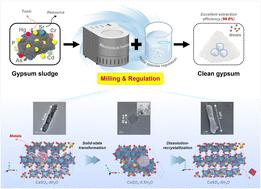当前位置:
X-MOL 学术
›
Environ. Sci.: Nano
›
论文详情
Our official English website, www.x-mol.net, welcomes your
feedback! (Note: you will need to create a separate account there.)
Effective separation of metal impurities from gypsum nanosludge: synergism of mechanical force and metal species regulation
Environmental Science: Nano ( IF 5.8 ) Pub Date : 2024-10-21 , DOI: 10.1039/d4en00799a Changzhou Weng, Zhengqiang Zheng, Chen Tian, Zhang Lin
Environmental Science: Nano ( IF 5.8 ) Pub Date : 2024-10-21 , DOI: 10.1039/d4en00799a Changzhou Weng, Zhengqiang Zheng, Chen Tian, Zhang Lin

|
The effective separation of metal impurities from gypsum sludges is crucial for both environmental protection and resource recovery. However, it is seriously limited by their entrapment within calcium sulfate crystal lattices. This study presents a universal strategy for metal extraction through combined control of mechanical force and metal species regulation, which effectively separated P, Cr, As, Sr, Cd, and Hg from gypsum sludges with separation efficiencies all above 94.0%, especially for As (99.8%) and Hg (99.2%). Such an exciting effect was due to the precise control of a two-step dehydration–rehydration transformation of gypsum. The process initiated by the mechanical force reduced the gypsum particle size from the microscale (∼10 μm) to the nanoscale (<50 nm), which facilitated the dehydration process of gypsum–bassanite to exclude the doped metals. In the subsequent rehydration process, the nanoparticles were also beneficial for disrupting the calcium sulfate framework of bassanite, leading to the full release of entrapped metals. Additionally, the application of species-regulating agents changed the species of released metals, preventing their re-incorporation into the calcium sulfate. This approach offered a promising method for the separation and recovery of heavy metals from gypsum sludges, providing valuable insights into the treatment of heavy metal-containing solid wastes.
中文翻译:

从石膏纳米污泥中有效分离金属杂质:机械力和金属种类调节的协同作用
从石膏污泥中有效分离金属杂质对于环境保护和资源回收都至关重要。然而,它受到它们被困在硫酸钙晶格中的严重限制。本研究提出了一种通过机械力和金属种类调节相结合的金属提取通用策略,可有效分离石膏污泥中的 P、CR、AS、SR、CD 和 Hg,分离效率均高于 94.0%,尤其是 As (99.8%) 和 Hg (99.2%)。如此令人兴奋的效果是由于对石膏的两步脱水-再水化转化的精确控制。由机械力启动的过程将石膏粒径从微米级 (∼10 μm) 减小到纳米级 (<50 nm),这促进了石膏-巴桑石的脱水过程以排除掺杂金属。在随后的再水化过程中,纳米颗粒还有利于破坏巴桑石的硫酸钙框架,导致截留金属的完全释放。此外,物种调节剂的应用改变了释放金属的种类,阻止它们重新掺入硫酸钙中。这种方法为从石膏污泥中分离和回收重金属提供了一种很有前途的方法,为处理含重金属的固体废物提供了有价值的见解。
更新日期:2024-10-21
中文翻译:

从石膏纳米污泥中有效分离金属杂质:机械力和金属种类调节的协同作用
从石膏污泥中有效分离金属杂质对于环境保护和资源回收都至关重要。然而,它受到它们被困在硫酸钙晶格中的严重限制。本研究提出了一种通过机械力和金属种类调节相结合的金属提取通用策略,可有效分离石膏污泥中的 P、CR、AS、SR、CD 和 Hg,分离效率均高于 94.0%,尤其是 As (99.8%) 和 Hg (99.2%)。如此令人兴奋的效果是由于对石膏的两步脱水-再水化转化的精确控制。由机械力启动的过程将石膏粒径从微米级 (∼10 μm) 减小到纳米级 (<50 nm),这促进了石膏-巴桑石的脱水过程以排除掺杂金属。在随后的再水化过程中,纳米颗粒还有利于破坏巴桑石的硫酸钙框架,导致截留金属的完全释放。此外,物种调节剂的应用改变了释放金属的种类,阻止它们重新掺入硫酸钙中。这种方法为从石膏污泥中分离和回收重金属提供了一种很有前途的方法,为处理含重金属的固体废物提供了有价值的见解。


















































 京公网安备 11010802027423号
京公网安备 11010802027423号